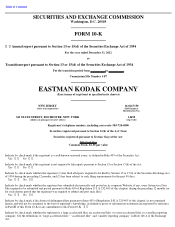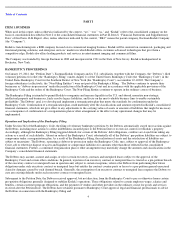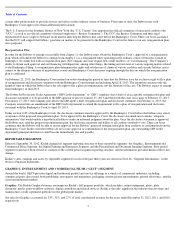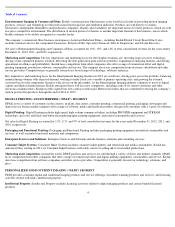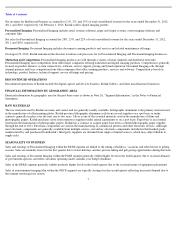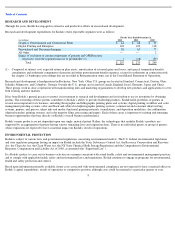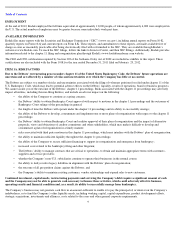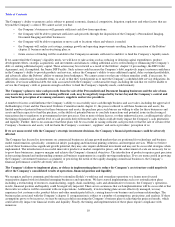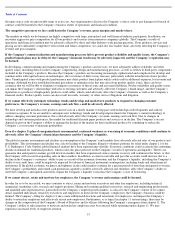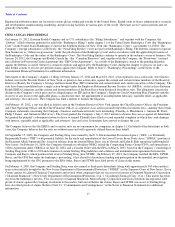Kodak 2012 Annual Report Download - page 12
Download and view the complete annual report
Please find page 12 of the 2012 Kodak annual report below. You can navigate through the pages in the report by either clicking on the pages listed below, or by using the keyword search tool below to find specific information within the annual report.
Table of Contents
laws and regulations, including local labor laws, and the failure to comply with such requirements may result in damages, fines and penalties
which could adversely affect the Company’s business.
The consummation of the Junior DIP Facility financing and borrowing of loans thereunder is subject to a number of conditions, and
there is no assurance that these conditions will be satisfied or waived. If we are unable to close our Junior DIP Financing on favorable
terms or at all, or if, in such event, we are unable to obtain alternative sources of financing, our ability to finance our operations may be
adversely affected.
The consummation of the Junior DIP Facility financing is subject to a number of conditions, including, among others, an amendment of our DIP
Credit Agreement becoming effective, the absence of any material adverse effect since September 30, 2012 and the occurrence of the closing of
the Junior DIP Facility no later than April 5, 2013. There is no assurance that these conditions will be satisfied or waived. If we fail to satisfy any
of these conditions, including any conditions to the amendment of our DIP Credit Agreement becoming effective, the financing under the Junior
DIP Facility will not be made available to us, which, unless we are able to secure alternative sources of financing, may adversely affect our
liquidity and, consequently, our businesses, operating results, financial condition and our ability to emerge from bankruptcy.
In addition, a portion of the loans under the Junior DIP Facility will convert into loans under the related exit facility if we meet the conditions
precedent to conversion. If we consummate our Junior DIP Financing but fail to meet the conditions precedent to conversion, we will be required
to repay in cash our Junior DIP Facility together with accrued and unpaid interest, which may adversely impact our ability to emerge from
bankruptcy.
The Company’s inability to effectively complete and manage divestitures and other significant transactions could adversely impact the
Company’s business performance including the Company’s financial results.
As part of the Company’s strategy, we are engaged in discussions with third parties regarding possible divestitures, asset sales, investments,
acquisitions, strategic alliances, joint ventures, and outsourcing transactions and enter into agreements relating to such transactions in order to
further the Company’s business objectives. In order to pursue this strategy successfully, we must identify suitable buyers, sellers and partners
and successfully complete transactions, some of which may be large and complex, and manage post closing issues such as the elimination of any
post sale cost overhang related to divested businesses. Risks of transactions can be more pronounced for larger and more complicated
transactions, or if multiple transactions are pursued simultaneously. If we fail to identify and successfully complete transactions that further the
Company’s strategic objectives, we may be required to expend resources to develop products and technology internally, we may be at a
competitive disadvantage or we may be adversely affected by negative market perceptions, any of which may have an adverse effect on the
Company’s revenue, gross margins and profitability. In addition, unpredictability surrounding the timing of such transactions could adversely
affect the Company’s financial results.
There can be no assurance that the Company will be able to meet the requirements under our DIP Credit Agreement and, if applicable,
the Junior DIP Facility.
In addition to standard financing covenants and events of default, the DIP Credit Agreement also provides for (i) a periodic delivery by the
Company of various financial statements set forth in the DIP Credit Agreement and (ii) specific milestones that the Company must achieve by
specific target dates. In addition, the Company and its subsidiaries are required not to permit consolidated adjusted EBITDA to be less than a
specified level for certain periods, and to maintain minimum U.S. Liquidity (as defined in the DIP Credit Agreement).
A breach of any of the covenants contained in the DIP Credit Agreement or related orders or our inability to comply with the required financial
covenants in this agreement, when applicable, could result in an event of default under the DIP Credit agreement, subject, in certain cases, to
applicable grace and cure periods. If any event of default occurs and we are not able either to cure it or obtain a waiver from the requisite lenders
under the agreement, the administrative agent of the DIP Credit Agreement may, and at the request of the requisite lenders shall, declare all of
our outstanding obligations under the agreement, together with accrued interest and fees, to be immediately due and payable, and the agent under
the agreement may, and at the request of the requisite lenders shall, terminate the lenders’ commitments under the DIP Credit Agreement and
cease making further loans, and if applicable, the agent could institute foreclosure proceedings against our pledged assets, which could result in
the Company being liquidated. The automatic stay that applies to pre-petition obligations under chapter 11 of the Bankruptcy Code does not
apply to these obligations. The lenders may demand more restrictive covenants, operational or business changes and/or economic compensation
as conditions to waiving any default or modifying terms prior to default. This could materially and adversely affect our operations, and our
ability to emerge from bankruptcy and to satisfy our obligations as they come due.
If we consummate the Junior DIP Facility financing, similar risks will apply with respect to our ability to meet the requirements of the Junior
DIP Facility.
There can be no assurance that the Company will be able to meet the requirements to convert certain loans into an exit facility.
The Junior DIP Facility provides for the conversion of certain loans thereunder into an exit facility, subject to certain conditions. If the Junior
DIP Facility financing is not completed, or if, in such event, we are not able to secure alternative financing, our ability to successfully emerge
from bankruptcy could be adversely affected.
Conditions to conversion into the exit facility include Bankruptcy Court approval of a plan of reorganization by September 15, 2013, with an
effective date no later than September 30, 2013; payment of $200 million of principal amount of New Money Loans; the resolution of all
obligations owing in respect of the KPP obligations on terms reasonably satisfactory to a certain majority of the Junior DIP Facility lenders, and


